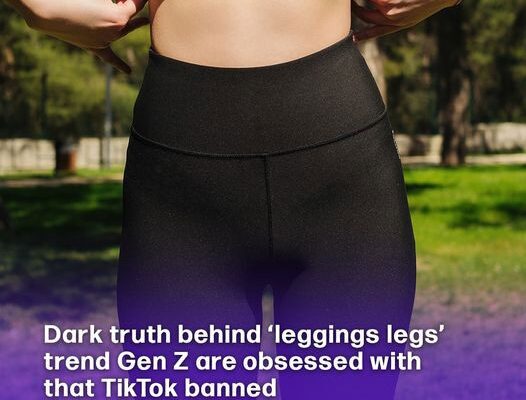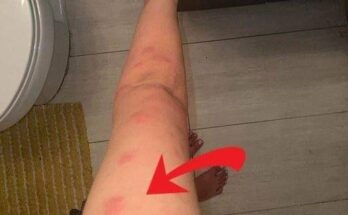
The Truth Behind ‘Leggings Legs’ Trend That Was Banned From TikTok
TikTok, known for its viral trends, dance challenges, and beauty hacks, has also seen its share of harmful fads. One such trend, called “leggings legs,” gained significant traction before TikTok stepped in and banned it for promoting negative body image. Here’s everything you need to know about the rise and fall of this controversial trend.
What Is the “Leggings Legs” Trend?

The trend began as users posted videos showcasing their legs in leggings, often comparing their appearance to an idealized image. The trend encouraged participants to flaunt having a “thigh gap”, signaling an unrealistic beauty standard where thinness is equated with attractiveness. This created pressure for many young women to fit into this narrow and harmful ideal.1
The Negative Impact on Body Image

As the trend spread, many users shared their struggles with feeling inadequate for not having “leggings legs.” Social media comments from young women highlighted the emotional toll this trend took on their mental health. One TikTok user wrote, “I have been crying for hours because I don’t have ‘leggings legs.’” Such reactions reveal how the trend exacerbated body dissatisfaction, similar to past harmful obsessions like the “thigh gap”.
Fitness Influencers Speak Out

Several influencers and experts expressed concerns about the damage this trend could inflict. Fitness influencer Steph Clare Smith, for example, shared her thoughts, saying, “I remember being obsessed with having a thigh gap… because social media told me that that was what was attractive. If you have legs and leggings, you have leggings legs. Don’t worry about what the internet says”.
TikTok’s Response and Ban

Due to growing concerns about the trend’s promotion of unhealthy body standards, TikTok acted swiftly. The platform banned the hashtag and redirected searches for “leggings legs” to resources for those struggling with body image and eating disorders, including links to organizations like the Butterfly Foundation.2 A TikTok spokesperson emphasized, “We do not allow content that depicts, promotes, normalizes, or glorifies eating disorders”.
Echoes of Past Harmful Trends

Experts have pointed out that “leggings legs” is reminiscent of past trends like the “thigh gap” and “bikini bridge.” These viral movements, similarly harmful, reinforced unattainable standards for women’s bodies. According to Lauren Gurrieri, an associate professor of marketing at Melbourne’s RMIT, trends like this push the idea that “being thin isn’t enough—you must achieve very specific ideals related to a part of your body”.3
Eating disorder recovery experts agree that trends like “leggings legs” send dangerous messages to vulnerable young people. Dr. Stephanie Miles, a research fellow at Orygen and the University of Melbourne, explained that “social media can make young people feel that their worth is tied to their appearance”. These trends exploit insecurities and can trigger or exacerbate eating disorders, particularly in teens already grappling with body image issues.
The Role of Social Media in Promoting Body Ideals

Research has consistently shown a connection between social media use and body dissatisfaction, particularly among young users. A study published in the International Journal of Environmental Research and Public Health found that exposure to idealized body types on platforms like TikTok can increase the risk of disordered eating behaviors. Another study pointed out that the “constant social comparisons” inherent to social media engagement fuel body image concerns.
Raising Awareness and Support

While harmful trends may seem inevitable on social media, platforms are beginning to take action. TikTok’s decision to ban the “leggings legs” trend and redirect users to mental health resources is a positive step. Other social platforms, such as Instagram and YouTube, have also implemented stricter policies and resources for users struggling with body image issues.
The Future of Body Positivity on Social Media

Despite harmful trends like “leggings legs,” there is hope that social media can become a more body-positive space. Influencers and advocates are working hard to shift the narrative away from unrealistic beauty standards, encouraging users to embrace body diversity. As more users speak out against harmful trends, there’s optimism that platforms will continue to adapt and protect vulnerable individuals from damaging content.
Conclusion

The “leggings legs” trend serves as a reminder of the influence social media has on body image, particularly among young women. While the trend was ultimately banned by TikTok, it underscores the need for ongoing vigilance in how we engage with and promote beauty standards online. By fostering inclusive, body-positive spaces, platforms can help mitigate the damaging effects of trends like this one.
Sources
- “Dark truth behind ‘leggings legs’ trend Gen Z are obsessed with that TikTok banned.” Tyla. Kya Buller. September 23, 2024.
- “What are ‘legging legs?’ What to know about the banned viral TikTok trend.” ABC News. February 2, 2024
- “TikTok blocks ‘dangerous’ ‘legging legs’ trend, as experts sound alarm on social media and eating disorders.” ABC. Zilla Gordon. February 3.



